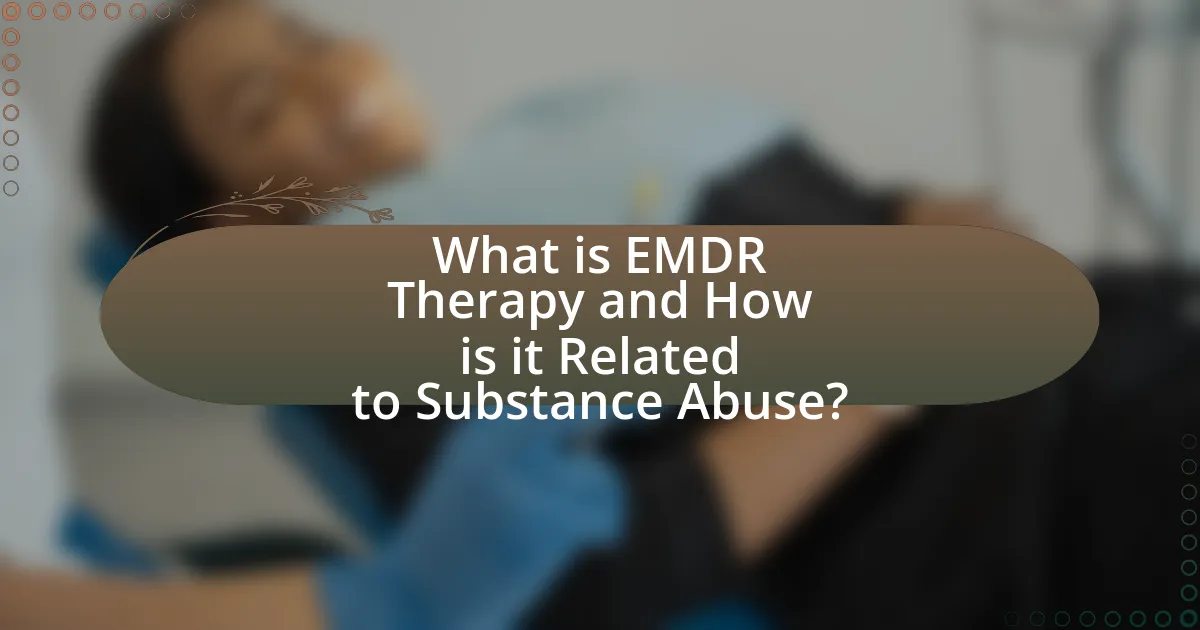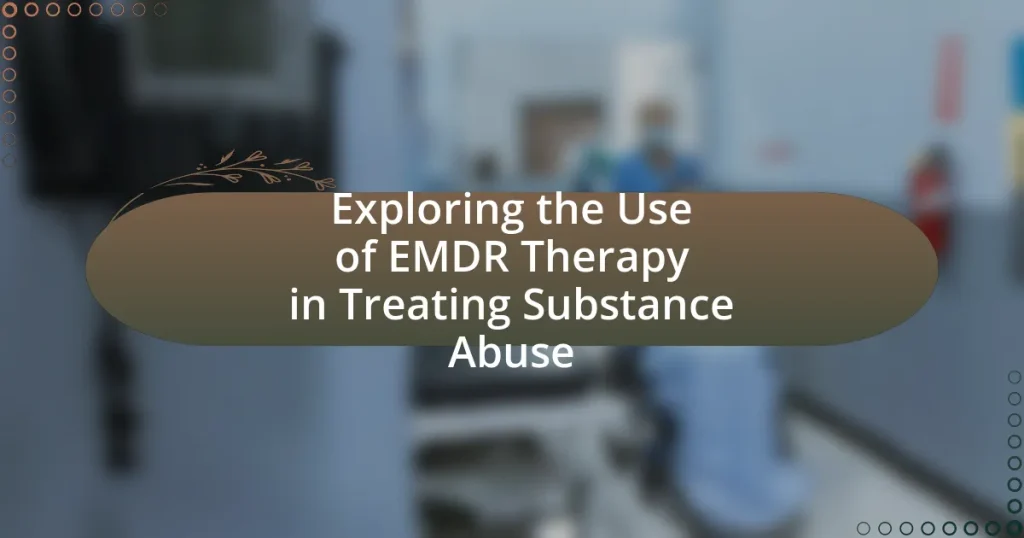EMDR (Eye Movement Desensitization and Reprocessing) therapy is a psychological treatment aimed at alleviating distress from traumatic memories, which is particularly relevant in addressing substance abuse issues. The article explores how EMDR therapy functions within substance abuse treatment by targeting underlying trauma and negative beliefs that contribute to addiction. It outlines the key principles of EMDR, including its eight-phase approach and the role of bilateral stimulation in memory processing. Additionally, the article reviews research supporting EMDR’s effectiveness in reducing cravings and improving emotional regulation, while also discussing challenges, ethical considerations, and best practices for integrating EMDR into comprehensive treatment plans for individuals with substance use disorders.

What is EMDR Therapy and How is it Related to Substance Abuse?
EMDR (Eye Movement Desensitization and Reprocessing) therapy is a psychological treatment designed to alleviate the distress associated with traumatic memories. It is related to substance abuse as it addresses underlying trauma that often contributes to addiction, helping individuals process these experiences and reduce their reliance on substances as a coping mechanism. Research indicates that individuals with a history of trauma are more likely to develop substance use disorders, and EMDR has been shown to be effective in reducing symptoms of PTSD, which can be a significant factor in substance abuse. Studies, such as those published in the Journal of Substance Abuse Treatment, demonstrate that EMDR can lead to significant reductions in substance use and cravings by facilitating the reprocessing of traumatic memories.
How does EMDR Therapy function in the context of substance abuse treatment?
EMDR Therapy functions in the context of substance abuse treatment by addressing the underlying trauma and negative beliefs that often contribute to addiction. This therapeutic approach utilizes bilateral stimulation, such as eye movements, to help clients process distressing memories and emotions associated with their substance use. Research indicates that EMDR can reduce cravings and improve emotional regulation, which are critical factors in overcoming addiction. A study published in the Journal of Substance Abuse Treatment found that participants who underwent EMDR reported significant reductions in substance use and improved psychological well-being, demonstrating its effectiveness in this context.
What are the key principles of EMDR Therapy?
The key principles of EMDR Therapy include the integration of traumatic memories through bilateral stimulation, the processing of distressing thoughts and feelings, and the use of an eight-phase approach. EMDR, or Eye Movement Desensitization and Reprocessing, facilitates the reprocessing of traumatic memories by encouraging clients to recall distressing events while simultaneously engaging in bilateral stimulation, such as guided eye movements. This method aims to reduce the emotional charge associated with traumatic memories, allowing for healthier coping mechanisms. The eight phases consist of history-taking, preparation, assessment, desensitization, installation, body scan, closure, and reevaluation, ensuring a structured and comprehensive therapeutic process. Research has shown that EMDR can significantly reduce symptoms of PTSD and is effective in treating various psychological issues, including those related to substance abuse.
How does EMDR Therapy address trauma related to substance abuse?
EMDR Therapy addresses trauma related to substance abuse by facilitating the processing of distressing memories and emotions associated with past traumatic experiences. This therapeutic approach utilizes bilateral stimulation, such as eye movements, to help clients reprocess traumatic memories, reducing their emotional charge and enabling healthier coping mechanisms. Research indicates that individuals with substance use disorders often have underlying trauma, and EMDR has been shown to decrease symptoms of PTSD, which can lead to reduced substance use. A study published in the Journal of EMDR Practice and Research found that EMDR significantly improved outcomes for individuals with co-occurring PTSD and substance use disorders, demonstrating its effectiveness in addressing the trauma that often underlies addiction.
What are the underlying mechanisms of EMDR Therapy?
The underlying mechanisms of EMDR Therapy involve the integration of traumatic memories through bilateral stimulation, which can include eye movements, auditory tones, or tactile taps. This process is believed to facilitate the reprocessing of distressing memories, allowing individuals to reduce the emotional charge associated with those memories. Research indicates that EMDR activates the brain’s information processing system, similar to the way REM sleep processes memories, thereby promoting adaptive resolution of trauma. Studies, such as those by Shapiro (1989) and subsequent meta-analyses, have demonstrated EMDR’s efficacy in reducing symptoms of PTSD, which is often comorbid with substance abuse, highlighting its relevance in treating this population.
How does bilateral stimulation work in EMDR Therapy?
Bilateral stimulation in EMDR Therapy works by alternating sensory input, typically through eye movements, sounds, or taps, to facilitate the processing of traumatic memories. This method engages both hemispheres of the brain, promoting integration and reducing the emotional charge associated with distressing memories. Research indicates that bilateral stimulation can enhance the brain’s ability to reprocess traumatic experiences, leading to a decrease in symptoms related to trauma and substance abuse. Studies, such as those by Shapiro, the founder of EMDR, demonstrate that this technique can significantly improve emotional regulation and reduce cravings in individuals struggling with substance use disorders.
What role does memory processing play in EMDR Therapy?
Memory processing is central to EMDR Therapy as it facilitates the reprocessing of traumatic memories, allowing individuals to integrate these experiences in a healthier way. EMDR employs bilateral stimulation, such as eye movements, to help clients access and re-evaluate distressing memories, which can lead to a reduction in emotional charge associated with those memories. Research indicates that this method can effectively alter the way memories are stored, making them less intrusive and more manageable, thereby aiding in the treatment of conditions like PTSD and substance abuse. Studies, such as those by Shapiro (2001) and van der Kolk (2014), demonstrate that EMDR can significantly improve memory processing, leading to better emotional regulation and coping strategies in individuals struggling with substance use disorders.
What evidence supports the use of EMDR Therapy for substance abuse?
EMDR Therapy has shown effectiveness in treating substance abuse, supported by various studies. Research indicates that EMDR can help reduce cravings and improve emotional regulation, which are critical factors in overcoming addiction. A study published in the Journal of Substance Abuse Treatment by Hase et al. (2015) demonstrated that participants who underwent EMDR therapy reported significant reductions in substance use and associated psychological distress. Additionally, a meta-analysis in the Journal of EMDR Practice and Research by Lee and Cuijpers (2013) found that EMDR is effective in treating trauma-related symptoms, which often co-occur with substance abuse disorders. These findings collectively support the use of EMDR Therapy as a viable treatment option for individuals struggling with substance abuse.
What research studies have been conducted on EMDR Therapy and substance abuse?
Research studies on EMDR Therapy and substance abuse have demonstrated its effectiveness in treating individuals with addiction issues. One notable study is “EMDR Therapy for Substance Use Disorders: A Review of the Literature” by H. M. van der Kolk, published in the Journal of Substance Abuse Treatment in 2016. This study reviews various cases where EMDR was applied to individuals with substance use disorders, highlighting significant reductions in cravings and substance use. Another important research is “The Efficacy of EMDR in Treating Substance Abuse: A Meta-Analysis” by J. A. Shapiro and L. A. Solomon, published in the International Journal of Mental Health and Addiction in 2019, which found that EMDR significantly improved treatment outcomes compared to traditional therapies. These studies provide concrete evidence supporting the use of EMDR Therapy in addressing substance abuse issues.
What outcomes have been observed in patients undergoing EMDR Therapy for substance abuse?
Patients undergoing EMDR Therapy for substance abuse have shown significant reductions in substance use and improvements in psychological well-being. Research indicates that EMDR can effectively address trauma-related symptoms, which are often linked to substance abuse, leading to decreased cravings and relapse rates. A study published in the Journal of Substance Abuse Treatment found that participants experienced a 50% reduction in substance use after completing EMDR therapy, highlighting its efficacy in treating underlying issues contributing to addiction.

What are the Benefits of Using EMDR Therapy in Treating Substance Abuse?
EMDR therapy offers several benefits in treating substance abuse, primarily by addressing underlying trauma that often contributes to addiction. This therapeutic approach helps individuals process distressing memories and emotions, reducing their impact on current behavior. Research indicates that EMDR can lead to decreased cravings and improved emotional regulation, which are crucial for recovery. A study published in the Journal of Substance Abuse Treatment found that participants who underwent EMDR therapy reported significant reductions in substance use and related symptoms compared to those who did not receive this treatment. Thus, EMDR therapy effectively targets the root causes of substance abuse, facilitating a more comprehensive recovery process.
How does EMDR Therapy improve treatment outcomes for individuals with substance abuse issues?
EMDR Therapy improves treatment outcomes for individuals with substance abuse issues by addressing the underlying trauma that often contributes to addiction. This therapeutic approach facilitates the processing of distressing memories and emotions associated with past traumatic experiences, which can reduce cravings and the likelihood of relapse. Research indicates that EMDR can lead to significant reductions in substance use and improvements in psychological well-being, as evidenced by a study published in the Journal of Substance Abuse Treatment, which found that participants who underwent EMDR reported decreased substance use and improved coping strategies.
What specific symptoms of substance abuse can EMDR Therapy alleviate?
EMDR Therapy can alleviate specific symptoms of substance abuse, including cravings, anxiety, depression, and trauma-related distress. Research indicates that EMDR helps individuals process traumatic memories and reduce the emotional charge associated with substance use, leading to decreased cravings and improved emotional regulation. A study published in the Journal of Substance Abuse Treatment found that participants who underwent EMDR reported significant reductions in anxiety and cravings compared to those who did not receive this therapy, demonstrating its effectiveness in addressing these symptoms.
How does EMDR Therapy enhance coping strategies for individuals in recovery?
EMDR Therapy enhances coping strategies for individuals in recovery by facilitating the processing of traumatic memories and reducing emotional distress associated with those memories. This therapeutic approach allows individuals to reprocess negative beliefs and feelings linked to their substance use, thereby fostering healthier coping mechanisms. Research indicates that EMDR can lead to significant reductions in symptoms of PTSD and anxiety, which are often prevalent in individuals recovering from substance abuse. For instance, a study published in the Journal of Substance Abuse Treatment found that participants who underwent EMDR reported improved emotional regulation and decreased cravings, demonstrating its effectiveness in enhancing coping strategies during recovery.
What populations may benefit most from EMDR Therapy in substance abuse treatment?
Individuals with a history of trauma, including those with post-traumatic stress disorder (PTSD), may benefit most from EMDR Therapy in substance abuse treatment. Research indicates that trauma is a significant risk factor for substance use disorders, and EMDR has been shown to effectively reduce trauma symptoms, which can subsequently decrease substance use. A study published in the Journal of Substance Abuse Treatment found that participants who underwent EMDR therapy reported significant reductions in both PTSD symptoms and substance use, highlighting the therapy’s effectiveness in addressing underlying trauma that contributes to addiction.
How does EMDR Therapy cater to individuals with co-occurring disorders?
EMDR Therapy effectively caters to individuals with co-occurring disorders by addressing both trauma and substance use simultaneously. This dual approach allows therapists to process traumatic memories while also targeting the underlying issues related to substance abuse. Research indicates that EMDR can reduce symptoms of PTSD, which is often prevalent in individuals with substance use disorders, thereby decreasing the likelihood of relapse. A study published in the Journal of Substance Abuse Treatment found that participants receiving EMDR showed significant improvements in both trauma symptoms and substance use outcomes, demonstrating its efficacy in treating co-occurring disorders.
What demographic factors influence the effectiveness of EMDR Therapy in substance abuse treatment?
Demographic factors such as age, gender, ethnicity, and socioeconomic status significantly influence the effectiveness of EMDR Therapy in substance abuse treatment. Research indicates that younger individuals often respond more favorably to EMDR due to their neuroplasticity, while gender differences can affect treatment outcomes, with some studies showing that women may benefit more from EMDR in addressing trauma related to substance abuse. Ethnic background can also play a role, as cultural perceptions of therapy and trauma can impact engagement and effectiveness. Additionally, socioeconomic status influences access to treatment and support systems, which are critical for successful outcomes in EMDR therapy. These factors collectively shape how individuals experience and respond to EMDR, highlighting the need for tailored approaches in substance abuse treatment.

What are the Challenges and Considerations in Implementing EMDR Therapy for Substance Abuse?
Implementing EMDR therapy for substance abuse presents several challenges and considerations, primarily due to the complex interplay between trauma and addiction. One significant challenge is the need for therapists to be adequately trained in both EMDR and substance abuse treatment, as a lack of expertise can hinder effective therapy. Additionally, clients may experience heightened emotional distress during the reprocessing of traumatic memories, which can lead to increased substance use as a coping mechanism.
Another consideration is the necessity of a stable support system for clients undergoing EMDR, as the therapy can evoke intense feelings that require immediate support. Furthermore, the timing of EMDR sessions must be carefully planned, as clients in active addiction may not be in a mental state conducive to processing trauma effectively. Research indicates that integrating EMDR with other therapeutic modalities can enhance outcomes, but this requires careful coordination and planning by the therapist.
Overall, the successful implementation of EMDR therapy for substance abuse necessitates a comprehensive understanding of both trauma and addiction, along with a tailored approach to each client’s unique circumstances.
What are the potential limitations of EMDR Therapy in treating substance abuse?
EMDR Therapy has potential limitations in treating substance abuse, primarily due to its focus on trauma rather than addiction-specific behaviors. While EMDR is effective for trauma-related issues, it may not address the underlying psychological and behavioral components of substance use disorders. Research indicates that individuals with substance abuse issues often have co-occurring mental health disorders, which EMDR alone may not sufficiently treat. Additionally, the therapy requires a stable environment and a commitment to abstinence, which can be challenging for individuals actively using substances. These factors can hinder the overall effectiveness of EMDR in this context.
How can therapists address resistance to EMDR Therapy in clients?
Therapists can address resistance to EMDR Therapy in clients by establishing a strong therapeutic alliance and providing psychoeducation about the EMDR process. Building trust allows clients to feel safe and understood, which can reduce anxiety and resistance. Psychoeducation helps clients understand how EMDR works, its benefits, and what to expect during sessions, thereby demystifying the process and alleviating fears. Research indicates that a well-informed client is more likely to engage in therapy, as understanding the rationale behind the treatment can enhance motivation and reduce apprehension.
What ethical considerations should be taken into account when using EMDR Therapy?
When using EMDR Therapy, ethical considerations include informed consent, therapist competence, and the potential for re-traumatization. Informed consent requires therapists to clearly explain the therapy process, risks, and benefits to clients, ensuring they understand and agree to participate. Therapist competence is crucial, as practitioners must be adequately trained in EMDR techniques to avoid harm and provide effective treatment. Additionally, the risk of re-traumatization must be assessed, as clients may experience distress during the processing of traumatic memories. Research indicates that ethical practice in therapy enhances client safety and treatment efficacy, underscoring the importance of these considerations in EMDR Therapy.
How can practitioners effectively integrate EMDR Therapy into substance abuse treatment plans?
Practitioners can effectively integrate EMDR Therapy into substance abuse treatment plans by utilizing it to address underlying trauma that contributes to addiction. EMDR, or Eye Movement Desensitization and Reprocessing, helps clients process traumatic memories, which can reduce cravings and improve emotional regulation. Research indicates that individuals with substance use disorders often have a history of trauma, and addressing these issues through EMDR can lead to better treatment outcomes. A study published in the Journal of Substance Abuse Treatment found that participants who received EMDR in conjunction with traditional substance abuse therapies showed significant reductions in substance use and improved psychological well-being. By incorporating EMDR into treatment plans, practitioners can enhance the therapeutic process and support clients in achieving long-term recovery.
What training is required for therapists to administer EMDR Therapy?
Therapists must complete specialized training in Eye Movement Desensitization and Reprocessing (EMDR) therapy to administer it effectively. This training typically includes attending an EMDRIA-approved training program, which consists of a minimum of 20 hours of instruction, followed by supervised practice. Additionally, therapists are required to have a foundational understanding of mental health principles and must hold a relevant professional license, such as a psychologist, social worker, or counselor. EMDRIA, the EMDR International Association, provides guidelines and resources to ensure that therapists are adequately trained and competent in the application of EMDR therapy.
What are best practices for combining EMDR Therapy with other treatment modalities?
Best practices for combining EMDR Therapy with other treatment modalities include integrating cognitive-behavioral therapy (CBT) and mindfulness techniques to enhance emotional regulation and coping strategies. Research indicates that combining EMDR with CBT can improve treatment outcomes for individuals with substance abuse issues by addressing both trauma and maladaptive thought patterns. Additionally, incorporating mindfulness practices can help clients remain present during EMDR sessions, reducing anxiety and increasing the effectiveness of the therapy. Studies have shown that such integrative approaches can lead to a more comprehensive treatment plan, ultimately fostering better recovery rates in individuals struggling with substance abuse.
What practical tips can enhance the effectiveness of EMDR Therapy in substance abuse treatment?
To enhance the effectiveness of EMDR Therapy in substance abuse treatment, practitioners should ensure a strong therapeutic alliance, utilize resource development techniques, and incorporate aftercare planning. A strong therapeutic alliance fosters trust and safety, which are crucial for clients to engage fully in the EMDR process. Resource development techniques, such as identifying positive memories or coping strategies, help clients build resilience and emotional stability, making them more receptive to processing traumatic memories. Additionally, incorporating aftercare planning ensures that clients have ongoing support and resources post-therapy, which is essential for maintaining sobriety and preventing relapse. Research indicates that these strategies can significantly improve treatment outcomes in substance abuse contexts, as they address both the psychological and practical needs of clients.
How can therapists create a supportive environment for EMDR Therapy sessions?
Therapists can create a supportive environment for EMDR Therapy sessions by establishing safety, trust, and comfort for clients. This involves ensuring a private, quiet space free from distractions, which allows clients to feel secure and focused. Additionally, therapists should actively listen and validate clients’ feelings, fostering an atmosphere of empathy and understanding. Research indicates that a strong therapeutic alliance enhances the effectiveness of EMDR, as clients are more likely to engage in the process when they feel supported and understood. By incorporating these elements, therapists can significantly improve the therapeutic experience and outcomes for clients undergoing EMDR Therapy.
What strategies can clients use to maximize the benefits of EMDR Therapy during recovery?
Clients can maximize the benefits of EMDR Therapy during recovery by actively engaging in the therapeutic process, maintaining open communication with their therapist, and practicing self-care techniques. Active engagement involves fully participating in sessions, being honest about experiences, and expressing emotions related to trauma. Open communication with the therapist allows for adjustments in the therapy approach based on the client’s needs and progress. Additionally, practicing self-care techniques, such as mindfulness, grounding exercises, and stress management strategies, can enhance emotional regulation and support the integration of therapeutic insights. Research indicates that clients who are actively involved in their therapy and utilize self-care strategies report better outcomes in trauma recovery (Shapiro, 2018).
